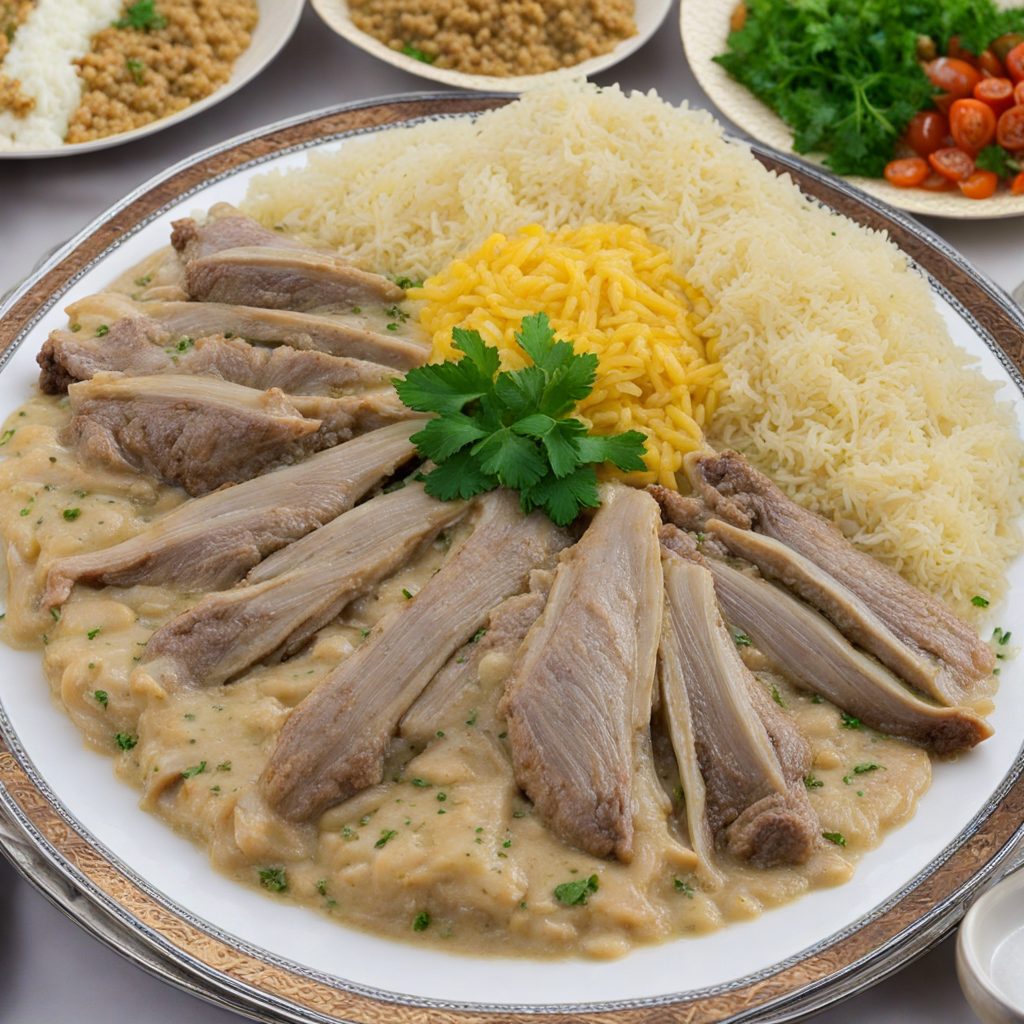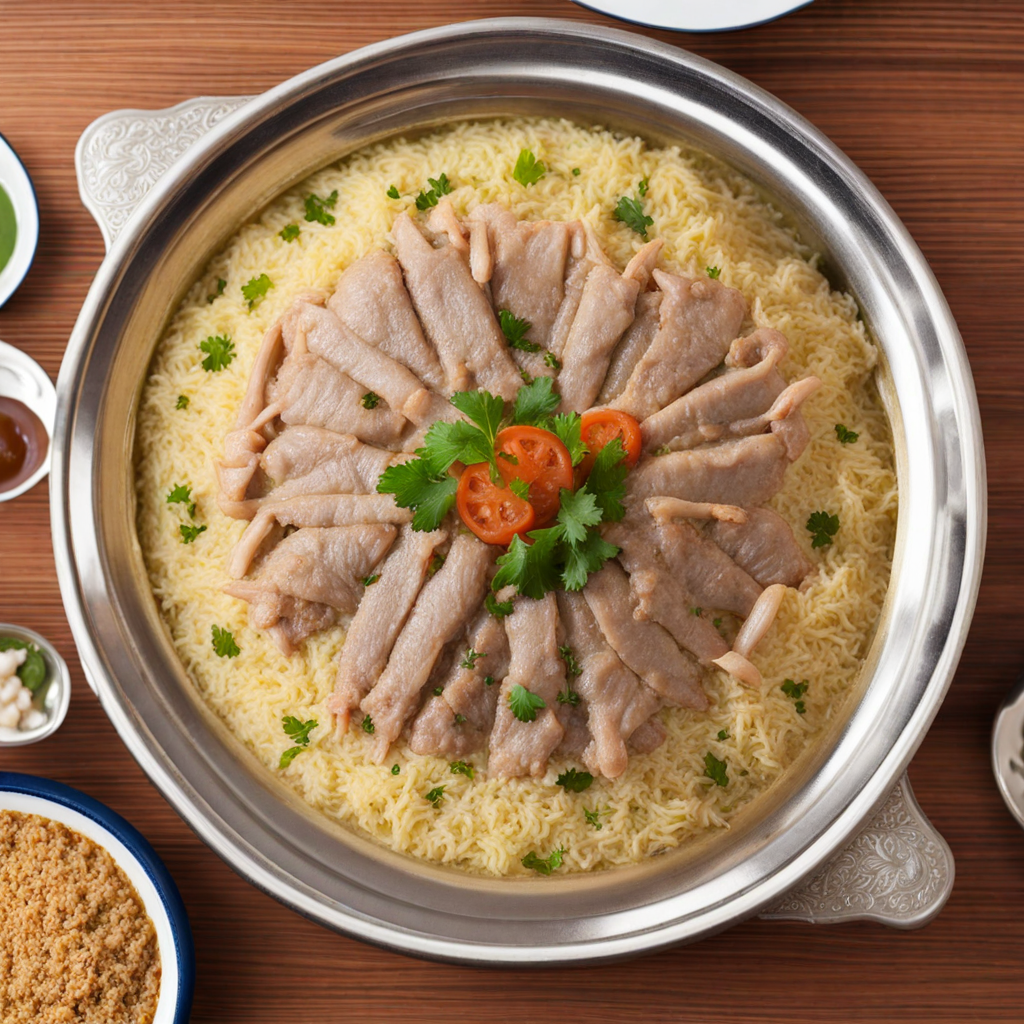Mansaf
Mansaf is a traditional Jordanian dish that embodies the rich culinary heritage of the region. At its core, Mansaf consists of tender, slow-cooked lamb that is infused with a unique blend of spices and served atop a bed of fragrant rice. The lamb is often simmered in a tangy sauce made from fermented dried yogurt called Jameed, which adds a distinctive sour flavor that complements the meat perfectly. This dish is not just a meal; it is a communal experience, often served on a large platter for family and friends to gather around and enjoy together. Accompanying the lamb and rice is a generous garnish of slivered almonds and pine nuts, which add a delightful crunch and a nutty flavor to each bite. Fresh herbs, such as parsley or mint, are often sprinkled on top for a burst of color and freshness. The rice, cooked to fluffy perfection, absorbs the savory juices from the lamb, creating a harmonious balance of flavors that is both satisfying and comforting. Traditionally, Mansaf is eaten with the hands, using pieces of flatbread to scoop up the meat and rice, enhancing the social and communal aspect of the meal. In Jordanian culture, Mansaf is more than just food; it is a symbol of hospitality and celebration. It is often served at special occasions, such as weddings, holidays, and family gatherings, showcasing the importance of sharing a meal with loved ones. Each bite of Mansaf is a taste of Jordan's rich history and traditions, inviting you to explore a world of flavors that are both unique and unforgettable. Whether you are dining in a local home or a restaurant, experiencing Mansaf is a culinary adventure that captures the essence of Jordanian cuisine.
How It Became This Dish
The dish known as المنسف (Mansaf) is a traditional Jordanian culinary treasure that holds a significant place in the cultural and social fabric of the country. Its origins trace back to the Bedouin tribes of the Arabian Peninsula, where it was initially a means of celebrating important events such as weddings, feasts, and other communal gatherings. The word "Mansaf" itself is derived from the Arabic root "نَسَفَ," which means "to spread," aptly describing the way the dish is presented, typically on a large platter meant to serve multiple people. The primary components of المنسف include lamb, rice, and a sauce known as جريشة (jameed) made from fermented dried yogurt. This unique sauce not only adds a distinctive flavor but also represents the Bedouin tradition of preserving dairy products in a harsh desert environment. The lamb is usually cooked until tender and is often seasoned with a mixture of spices, including cumin and cardamom, which enhances the dish's depth of flavor. The rice is usually cooked separately, often enriched with saffron or turmeric for color, and then served on a large platter beneath the succulent meat. In the Bedouin culture, food is not just sustenance; it is an expression of hospitality and generosity. المنسف is often served in communal settings, where diners gather around the platter, using their right hands to take portions of rice and meat. This communal style of eating fosters a sense of unity and togetherness among participants. Traditionally, the host is expected to provide ample food, reflecting their hospitality; it is considered an honor to share المنسف with guests. The practice of eating together underscores the importance of community in Jordanian culture. Historically, المنسف has evolved through the influence of various cultures and regions. With its roots in Bedouin tradition, the dish has been shaped by the agricultural practices and culinary influences of the Levant. As the region transitioned from nomadic lifestyles to settled agriculture, the ingredients and methods of preparation adapted accordingly. The introduction of rice as a staple grain transformed the dish, making it more widely accessible and popular among different social classes. Over the centuries, المنسف has also become a symbol of Jordanian identity. National celebrations, family gatherings, and religious holidays often feature this dish, reinforcing its status as a beloved cultural artifact. The dish's presence at significant life events, such as weddings and births, signifies its importance in commemorating milestones and fostering social bonds. In this way, المنسف serves not only as food but also as an embodiment of cultural heritage. The preparation of المنسف is an art form in itself, requiring skill and patience. The traditional method involves cooking the lamb slowly in a large pot, allowing the flavors to meld beautifully. Once the meat is tender, the jameed sauce is added, creating a rich, tangy flavor that permeates the dish. The rice is typically placed on a large dish, with the meat artfully arranged on top and garnished with pine nuts or almonds. Some variations include the addition of raisins or fried onions, which enhance the overall flavor profile. In recent years, المنسف has gained international recognition, celebrated not only for its taste but also for its cultural significance. Restaurants around the world have started to feature this iconic dish on their menus, introducing it to a broader audience and allowing people to experience a taste of Jordanian hospitality. Food festivals and cultural events often showcase المنسف, where chefs compete to create the best version, further elevating its status within the culinary world. Modern adaptations of المنسف have also emerged, reflecting the influences of contemporary cooking techniques and dietary preferences. While the traditional version remains the most popular, variations using chicken or even vegetarian options have become available, catering to diverse palates. Moreover, the rise of social media has propelled food photography, leading to a visual celebration of المنسف that has captivated audiences worldwide. Instagram and food blogs have helped to share not only the dish's appearance but also the stories behind it, encouraging a deeper appreciation for Jordanian cuisine. Despite these modern adaptations, the essence of المنسف remains rooted in tradition, emphasizing communal dining and the importance of family and friendship. As it continues to be a staple at gatherings, the dish reinforces the values of hospitality and generosity that are central to Jordanian culture. Its enduring popularity is a testament to the dish's ability to bring people together, transcending barriers and fostering connections through the shared experience of food. In conclusion, المنسف is more than just a meal; it is a reflection of Jordan's rich cultural tapestry, steeped in history and tradition. From its Bedouin origins to its modern-day status as a symbol of hospitality, المنسف embodies the spirit of community and celebration in Jordan. As the world continues to embrace diverse culinary experiences, the legacy of المنسف will undoubtedly endure, inviting both locals and visitors alike to partake in its rich flavors and cultural significance.
You may like
Discover local flavors from Jordan







